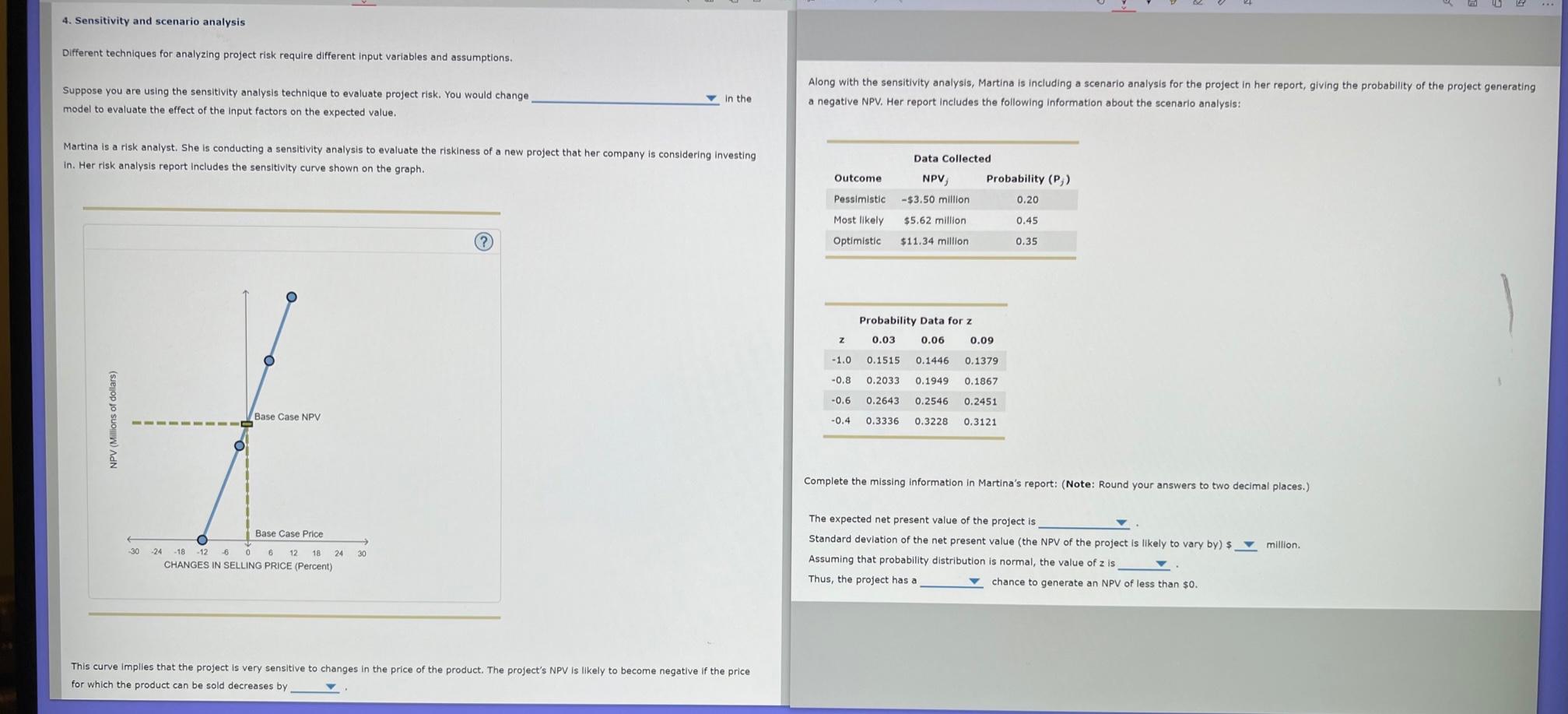
4. Sensitivity and scenario analysis Different techniques for analyzing project risk require different input variables and assumptions. Suppose you are using the sensitivity analysis technique to evaluate project risk. You would change model to evaluate the effect of the input factors on the expected value. Along with the sensitivity analysis, Martina is including a scenario analysis for the project in her report, giving the probability of the project generating a negative NPV. Her report includes the following information about the scenario analysis: in the Martina is a risk analyst. She is conducting a sensitivity analysis to evaluate the riskiness of a new project that her company is considering Investing in. Her risk analysis report Includes the sensitivity curve shown on the graph, Outcome Data collected NPV) Probability (P) -$3.50 million 0.20 Pessimistic Most likely $5.62 million 0.45 Optimistic $11.34 million 0.35 Probability Data for z 0.03 0.06 0.09 Z 0.1446 0.1379 -0.8 0.2033 0.1949 0.1867 -0.6 0.2643 0.2546 0.2451 NPV (Millions of dollars) Base Case NPV -0.4 0.3336 0.3228 0.3121 Complete the missing information in Martina's report: (Note: Round your answers to two decimal places.) million. Base Case Price 30 24 -18 -12 -8 0 6 12 18 24 CHANGES IN SELLING PRICE (Percent) 30 The expected net present value of the project is Standard deviation of the net present value (the NPV of the project is likely to vary by) $ Assuming that probability distribution is normal, the value of z is Thus, the project has a chance to generate an NPV of less than $0. This curve Implies that the project is very sensitive to changes in the price of the product. The project's NPV is likely to become negative if the price for which the product can be sold decreases by 4. Sensitivity and scenario analysis Different techniques for analyzing project risk require different input variables and assumptions. Suppose you are using the sensitivity analysis technique to evaluate project risk. You would change model to evaluate the effect of the input factors on the expected value. Along with the sensitivity analysis, Martina is including a scenario analysis for the project in her report, giving the probability of the project generating a negative NPV. Her report includes the following information about the scenario analysis: in the Martina is a risk analyst. She is conducting a sensitivity analysis to evaluate the riskiness of a new project that her company is considering Investing in. Her risk analysis report Includes the sensitivity curve shown on the graph, Outcome Data collected NPV) Probability (P) -$3.50 million 0.20 Pessimistic Most likely $5.62 million 0.45 Optimistic $11.34 million 0.35 Probability Data for z 0.03 0.06 0.09 Z 0.1446 0.1379 -0.8 0.2033 0.1949 0.1867 -0.6 0.2643 0.2546 0.2451 NPV (Millions of dollars) Base Case NPV -0.4 0.3336 0.3228 0.3121 Complete the missing information in Martina's report: (Note: Round your answers to two decimal places.) million. Base Case Price 30 24 -18 -12 -8 0 6 12 18 24 CHANGES IN SELLING PRICE (Percent) 30 The expected net present value of the project is Standard deviation of the net present value (the NPV of the project is likely to vary by) $ Assuming that probability distribution is normal, the value of z is Thus, the project has a chance to generate an NPV of less than $0. This curve Implies that the project is very sensitive to changes in the price of the product. The project's NPV is likely to become negative if the price for which the product can be sold decreases by







